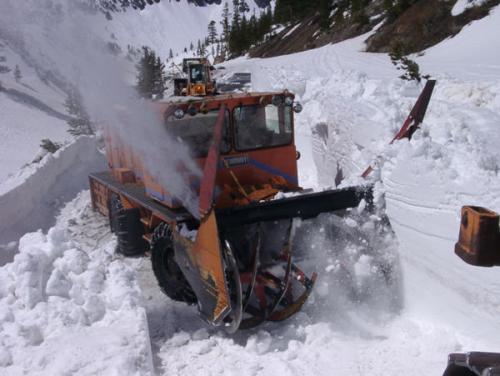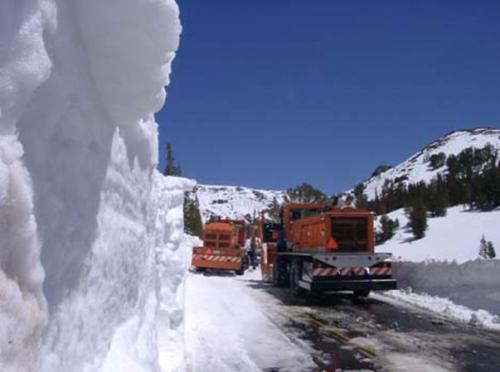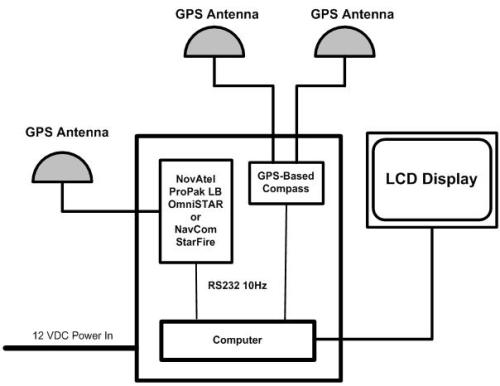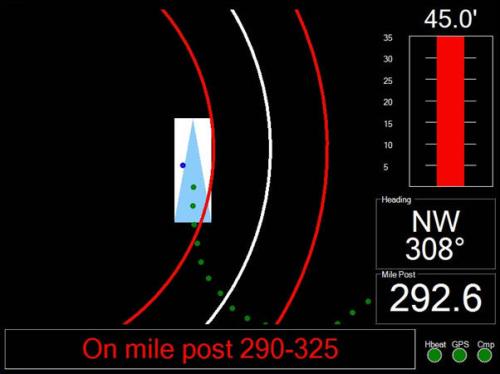
GPS-Based Driver Assistance System Makes Mountain Pass Opening Safer
| Outcome | Deliver portable road opening hardware and software. Delivery: June, 2008 |
|---|---|
| Benefit | Improves road availability for the public, and safety and efficiency for Caltrans. Provides the operator with a visual display that will help them find mountain pass roads covered by deep snow, and safely and efficiently open passes to the traveling public. |
AHMCT researchers are developing a driver assistance system for mountain pass opening. The portable system provides the operator with a display indicating location and height above the road, vehicle heading, and system status. Sensing is provided by GPS with satellite-based differential corrections, along with a dual-antenna GPS-based compass for heading.
Why We Are Pursuing This Research
Some mountain pass roads are closed over the winter, and buried deep in snow by the spring–opening these passes is a difficult and dangerous job. There are few indicators to help find the road, and over time some of these indicators may no longer be available. The current research will develop a system to provide the operator with a visual display that will help them find the road, and safely and efficiently open the pass to the traveling public.

What We Are Doing
AHMCT researchers are developing a driver-assistance system to support mountain pass opening. The system provides an in-cab display for the operator, with all essential information to allow them to safely, efficiently, and accurately guide the vehicle over the roadway, even when the road is obscured by over thirty feet of snow. Since the smaller rotary plows used for this operation are often shared among maintenance yards, and the road opening operation occurs at varying times in each area, the system will be portable. In particular, the system will be designed so it is easily installed, calibrated, and removed, and will work on a variety of vehicle types.

The system determines vehicle location using the Global Positioning System (GPS). Accuracy of uncorrected GPS is not sufficient for this application. To safely find the road center and keep the vehicle over the road, sub-meter accuracy is crucial. However, many locations do not have the necessary differential base station to provide this level of accuracy. To achieve the accuracy desired while avoiding additional infrastructure, the current system uses a Satellite-Based Augmentation System (SBAS) to provide differential corrections, and achieves 4 inch (10-cm) accuracy. This is more than sufficient for the current task, and the SBAS signal is available continent-wide.
Vehicle heading vs. the road heading is also essential, so that the blower operator can continue moving along the road. A dual-antenna GPS-based compass provides the heading of the vehicle, which allows display of vehicle vs. road heading.

The system also provides height above the roadway, as well as text-based information indicating how far along the current pass opening has advanced, e.g. milepost readings. The GPS again provides this information. Underlying the GPS sensing, a key part of the system is the Geographic Information System (GIS) base map, which includes information on the roadway location (centerline, shoulders, lanes), as well as roadside features, including signs. From this GIS, the system can determine location along the road, and provide the operator with milepost numbers, as well as text messages for familiar local landmarks, upcoming intersections, and system status.


To assure safety, the system includes a watchdog feature, and status indicators for all sensing systems. The status indicators provide an immediate indication of the function of the system, e.g. whether the GPS receiver sees enough satellites, whether differential correction information is available, etc. The watchdog subsystem monitors the overall code execution, and provides a pulsing heartbeat. In the rare circumstance of a system freeze, this heartbeat would also stop, and the operator could tell that the system was no longer reliable. In normal conditions, if the sensing degrades (e.g. due to loss of satellites) beyond an acceptable level, the operator is notified and the system will not provide faulty guidance information.
Current Status
Researchers tested the prototype during the Spring 2005 and 2006 openings of Sonora Pass on State Route 108, north of Yosemite, CA. Additional field testing by Caltrans Maintenance personnel occurred in April 2007. Based on results and operator feedback, providing GPS-based driver assistance for mountain pass opening is feasible, and holds great promise for enhancing the safety and efficiency of this operation. Updates to the system, based on operator feedback, are in progress, with final deployment testing in Spring 2008. Based on the state-of-the-art and the trends in GPS system performance and cost, GPS-based driver assistance for pass opening is both feasible and cost-effective, and commercial prospects are promising.
For Additional Information
| Larry Baumeister Caltrans Project Manager |
Larry_Baumeister@dot.ca.gov | (916) 227-5835 |
| Bahram Ravani Principal investigator |
bravani@ucdavis.edu | (530) 754-6130 |
| Ty A. Lasky Co-Principal investigator |
talasky@ucdavis.edu | (530) 752-6366 |
| Kin S. Yen Primary contact |
ksyen@ucdavis.edu | (530) 754-7401 |
This document is disseminated in the interest of information exchange. The contents do not necessarily reflect the official views or policies of the AHMCT Research Center, the University of California, the State of California, or the Federal Highway Administration. This document does not constitute a standard, specification, regulation, or imply endorsement of the conclusions or recommendations.
(rev. May 2007)
